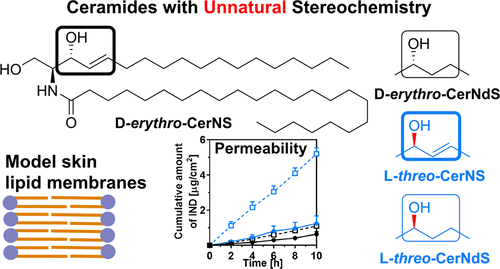Our official English website, www.x-mol.net, welcomes your
feedback! (Note: you will need to create a separate account there.)
Effects of Ceramide and Dihydroceramide Stereochemistry at C-3 on the Phase Behavior and Permeability of Skin Lipid Membranes
Langmuir ( IF 3.7 ) Pub Date : 2017-12-26 00:00:00 , DOI: 10.1021/acs.langmuir.7b03448
Andrej Kováčik 1 , Petra Pullmannová 1 , Jaroslav Maixner 2 , Kateřina Vávrová 1
Langmuir ( IF 3.7 ) Pub Date : 2017-12-26 00:00:00 , DOI: 10.1021/acs.langmuir.7b03448
Andrej Kováčik 1 , Petra Pullmannová 1 , Jaroslav Maixner 2 , Kateřina Vávrová 1
Affiliation

|
Ceramides (Cer) are key components of the skin permeability barrier. Sphingosine-based CerNS and dihydrosphingosine-based CerNdS (dihydroCer) have two chiral centers; however, the importance of the correct stereochemistry in the skin barrier Cer is unknown. We investigated the role of the configuration at C-3 of CerNS and CerNdS in the organization and permeability of model skin lipid membranes. Unnatural l-threo-CerNS and l-threo-CerNdS with 24-C acyl chains were synthesized and, along with their natural d-erythro-isomers, incorporated into membranes composed of major stratum corneum lipids (Cer, free fatty acids, cholesterol, and cholesteryl sulfate). The membrane microstructure was investigated by X-ray powder diffraction and infrared spectroscopy, including deuterated free fatty acids. Inversion of the C-3 configuration in CerNS and CerNdS increased phase transition temperatures, had no significant effects on lamellar phases, but also decreased the proportion of orthorhombic packing and decreased lipid mixing in the model membranes. These changes in membrane organization resulted in membrane permeabilities that ranged from unchanged to 5-fold higher (depending on the permeability markers, namely, water loss, electrical impedance, flux of theophylline, and flux of indomethacin) compared to membranes with natural CerNS/NdS isomers. Thus, the physiological d-erythro stereochemistry of skin Cer and dihydroCer appears to be essential for their correct barrier function.
中文翻译:

神经酰胺和二氢神经酰胺的立体化学在C-3对皮肤脂质膜的相行为和渗透性的影响
神经酰胺(Cer)是皮肤渗透屏障的关键成分。基于鞘氨醇的CerNS和基于二氢鞘氨醇的CerNdS(dihydroCer)具有两个手性中心。然而,尚不清楚在皮肤屏障Cer中正确的立体化学的重要性。我们调查了CerNS和CerNdS的C-3构型在模型皮肤脂质膜的组织和渗透性中的作用。非自然升-苏型-CerNS和升-苏式24-C酰基链-CerNdS合成,并与它们的自然沿d -赤-异构体,掺入由主要角质层脂质(Cer,游离脂肪酸,胆固醇和胆固醇硫酸酯)组成的膜中。通过X射线粉末衍射和红外光谱研究膜的微观结构,包括氘化的游离脂肪酸。CerNS和CerNdS中C-3构型的反转增加了相变温度,对层状相没有显着影响,但也降低了正交晶堆积的比例并减少了模型膜中的脂质混合。与具有天然CerNS / NdS的膜相比,这些膜组织的变化导致膜的渗透率范围从不变到较高的5倍(取决于渗透性标记,即失水,电阻抗,茶碱的通量和消炎痛的通量)。异构体。因此,生理d -赤皮CER和dihydroCer的立体似乎是其正确的屏障功能是必不可少的。
更新日期:2017-12-26
中文翻译:

神经酰胺和二氢神经酰胺的立体化学在C-3对皮肤脂质膜的相行为和渗透性的影响
神经酰胺(Cer)是皮肤渗透屏障的关键成分。基于鞘氨醇的CerNS和基于二氢鞘氨醇的CerNdS(dihydroCer)具有两个手性中心。然而,尚不清楚在皮肤屏障Cer中正确的立体化学的重要性。我们调查了CerNS和CerNdS的C-3构型在模型皮肤脂质膜的组织和渗透性中的作用。非自然升-苏型-CerNS和升-苏式24-C酰基链-CerNdS合成,并与它们的自然沿d -赤-异构体,掺入由主要角质层脂质(Cer,游离脂肪酸,胆固醇和胆固醇硫酸酯)组成的膜中。通过X射线粉末衍射和红外光谱研究膜的微观结构,包括氘化的游离脂肪酸。CerNS和CerNdS中C-3构型的反转增加了相变温度,对层状相没有显着影响,但也降低了正交晶堆积的比例并减少了模型膜中的脂质混合。与具有天然CerNS / NdS的膜相比,这些膜组织的变化导致膜的渗透率范围从不变到较高的5倍(取决于渗透性标记,即失水,电阻抗,茶碱的通量和消炎痛的通量)。异构体。因此,生理d -赤皮CER和dihydroCer的立体似乎是其正确的屏障功能是必不可少的。

































 京公网安备 11010802027423号
京公网安备 11010802027423号